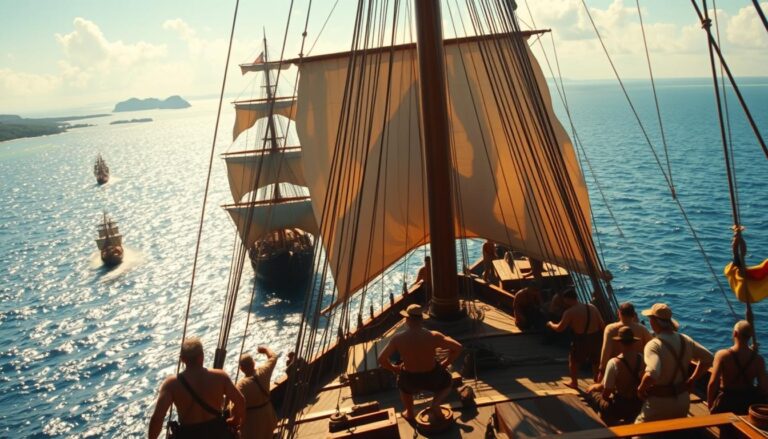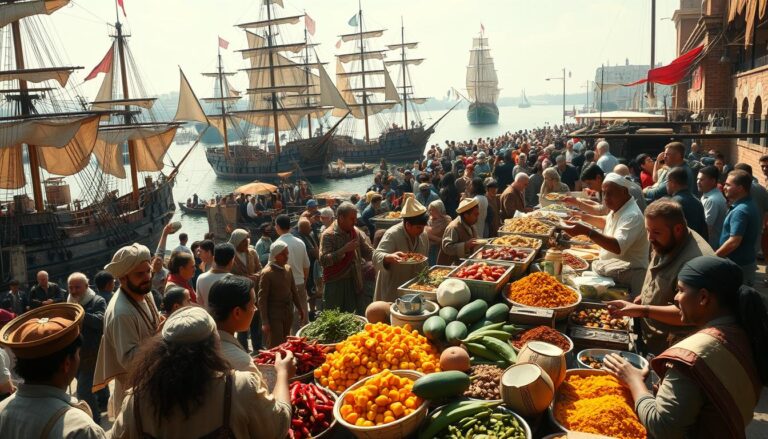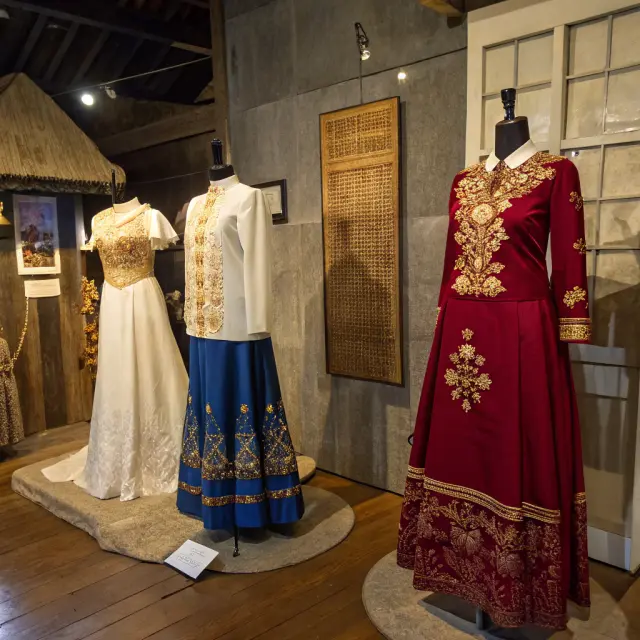Andres Bonifacio: Hero of the Philippine Revolution
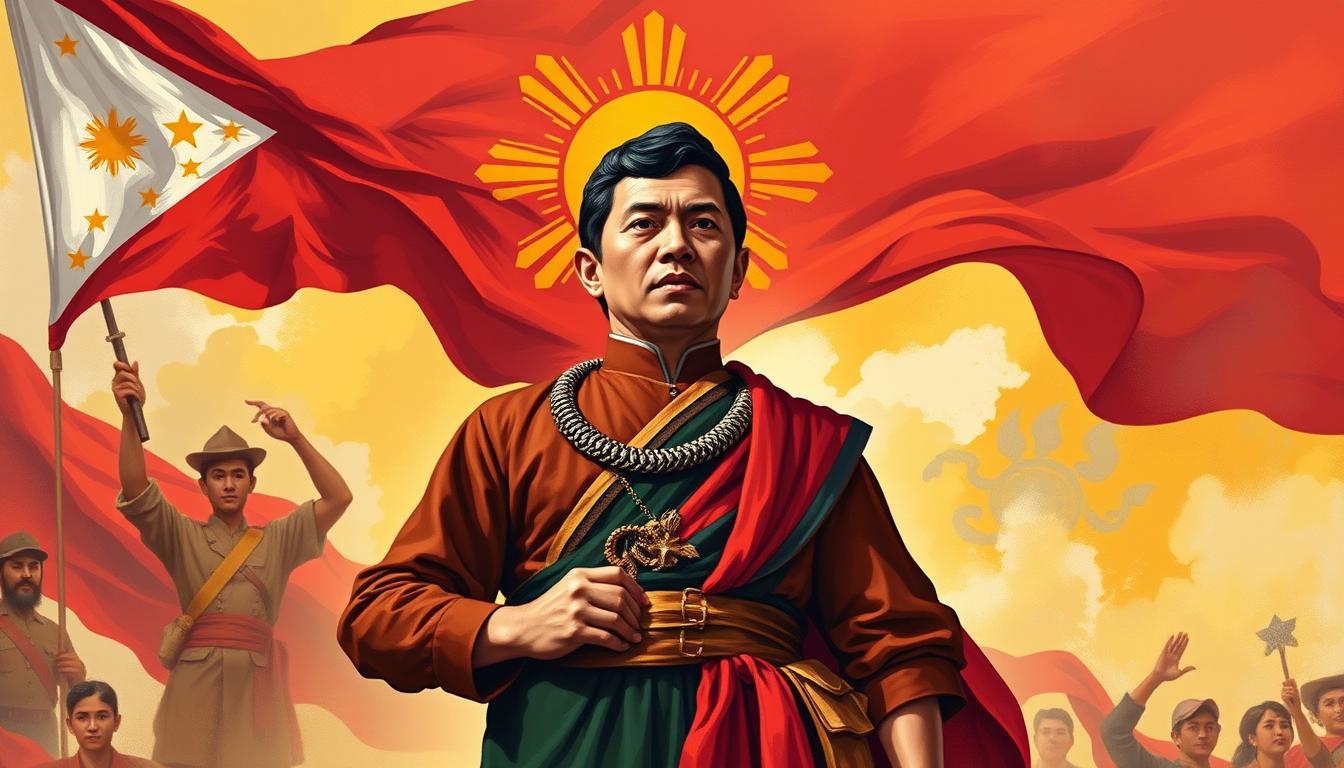
Did you know Andres Bonifacio’s secret society, the Katipunan, grew to over 30,000 members in just four years? This shows how Bonifacio’s vision and ideas inspired many Filipinos to fight against Spanish rule. Born on November 30, 1863, in Tondo, Manila, Andres Bonifacio is known as the Father of the Philippine Revolution.
He had a humble start and was self-taught. Yet, his journey as a Filipino Revolutionist is truly inspiring and crucial for the nation’s fight for freedom.
His actions sparked a revolution and shaped the Philippines’ future. Despite facing many challenges and a tragic end on May 10, 1897, his legacy inspires many. This article explores Andres Bonifacio’s life and achievements, highlighting his role as a national hero.
Key Takeaways
- Andres Bonifacio was born in Tondo, Manila, a pivotal figure in the fight for Philippine independence.
- The Katipunan, founded by Bonifacio, became a powerful organization advocating for freedom from Spanish rule.
- Despite limited formal education, Bonifacio educated himself on revolutionary ideas and principles.
- His leadership was instrumental during the initial stages of the Philippine Revolution.
- Bonifacio’s tragic execution in 1897 marked a significant turning point in Philippine history.
- Today, he is celebrated as the Father of the Philippine Revolution and a symbol of Filipino nationalism.
Introduction to Andres Bonifacio
Andres Bonifacio was born on November 30, 1863, in Manila, Philippines. He is a key figure in Filipino history. He fought for the Philippines’ freedom from Spanish rule.
His early life was simple, but he had a big dream for freedom and equality. These dreams made him a brave leader.
In 1892, Bonifacio helped start the Katipunan. This group aimed to win independence. Under him, the Katipunan grew from 300 to over 30,000 members.
This growth showed his skill in bringing people together. It showed his vision for a free nation.
Bonifacio took part in important battles like the Cry of Pugad Lawin and the Battle of Manila. His leadership and passion inspired many. He fought for social justice and freedom.
His legacy reminds us of the value of national pride and working together. He is a hero in Philippine history.
Early Life and Education
Andres Bonifacio’s early life was key to his future as a leader. He was born on November 30, 1863, in Tondo, Manila. He was the eldest of six, facing many challenges.
His parents died young, making him the caretaker for his siblings. This experience shaped him and made him work hard from a young age.
Background and Family
Andres Bonifacio’s family story is one of resilience. His parents, Catalina de Castro and Santiago Bonifacio, died of tuberculosis when he was 14. He then took on adult responsibilities.
He had little formal education but attended Guillermo Osmeña’s school. When money was tight, he worked as a clerk-messenger in a British firm. He also learned English, showing his dedication to learning.
Self-Education and Early Influences
Andres Bonifacio was mostly self-taught. He read a lot, including about the French and American Revolutions. He also read Jose Rizal’s novels, which inspired him to seek change.
These readings shaped his vision for the Philippines. His story shows that hard work and self-education can overcome obstacles.

| Aspect | Details |
|---|---|
| Date of Birth | November 30, 1863 |
| Number of Siblings | Five |
| Educational Background | Guillermo Osmeña’s private school |
| Career Start | Clerk-messenger at a British firm |
| Major Influences | Works on French and American Revolutions, novels by Jose Rizal |
The Rise of a Filipino Revolutionist
Andres Bonifacio’s journey into politics started in the late 19th century Philippines. He joined La Liga Filipina, a group founded by José Rizal in 1892. This group aimed to fight against Spain’s rule, marking a key moment in Bonifacio’s path to revolution.
Initial Involvement in Politics
By joining La Liga Filipina, Bonifacio met others who wanted to change their society. The Liga sought reforms like better representation and rights under Spain’s rule. Bonifacio believed in the power of organized efforts to bring about change.
Political Activism with La Liga Filipina
After José Rizal’s arrest in December 1896, Bonifacio turned to a more radical fight for freedom. He became the Liga’s chief propagandist, working to grow their movement. His activism showed the need for independence and an end to colonial rule. His efforts helped the Katipunan grow, reaching up to 400,000 members by August 1896.
Bonifacio’s leadership in La Liga Filipina paved the way for more revolutionary actions. He became a key figure in the fight against colonial rule. His activism aimed to wake up Filipinos, sparking the Philippine Revolution.
Founding the Katipunan
In the late 19th century, a key event in Philippine history happened. The Katipunan was founded on July 7, 1892, in Manila. Andres Bonifacio, Deodato Arellano, and others started this secret society. It aimed to end Spanish rule.
The Katipunan was a big step towards freedom. It showed a shift from wanting change to wanting a real revolution.
The Significance of the Katipunan
The Katipunan was very important in the fight for freedom. It brought Filipinos together, giving them a chance to fight for their rights. The group wanted to break free from Spain.
It offered a way to resist the oppressors. This gave hope to many Filipinos. Later, women joined, showing the group’s commitment to freedom for all.
Bonifacio’s Role as Supremo of the Katipunan
Andres Bonifacio was the leader of the Katipunan. He was chosen in January 1894. He led the fight against Spanish rule with great skill.
Under his leadership, the Katipunan grew fast. Bonifacio taught his followers about civic virtues and national pride. He also started *Kalayaan* (Freedom) in March 1896. This helped spread the movement’s message.
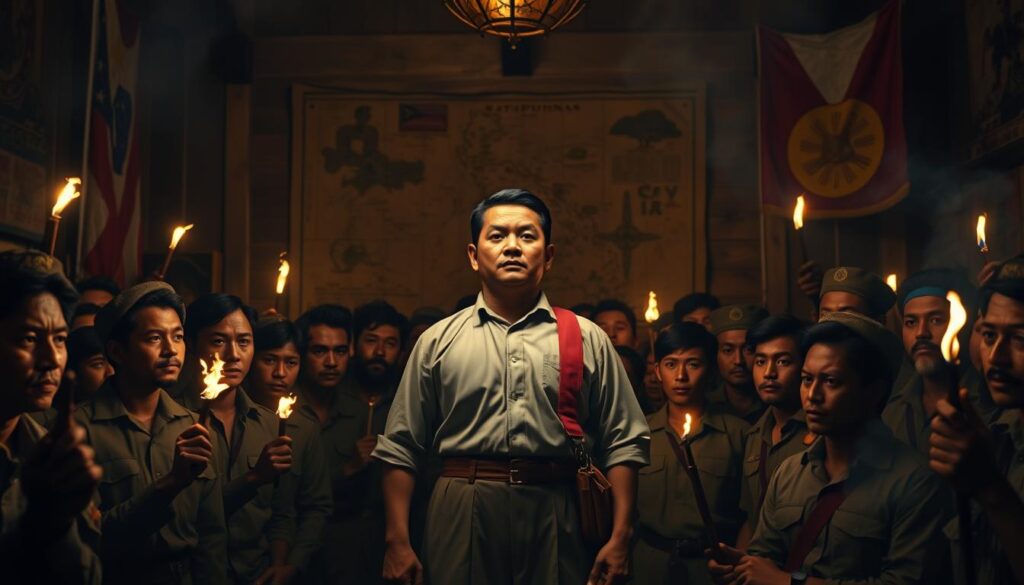
| Key Information | Details |
|---|---|
| Founded | July 7, 1892 |
| Location | Manila, Philippines |
| Founders | Andres Bonifacio, Deodato Arellano, Valentín Díaz, José Dizon, Teodoro Plata, Ladislao Diwa |
| Bonifacio’s Title | Supremo of the Katipunan |
| Termination | March 22, 1897 |
| Main Publication | Kalayaan |
| Major Achievements | Mobilization for Filipino Revolution, Education on civic virtues |
Andres Bonifacio and the Philippine Revolution
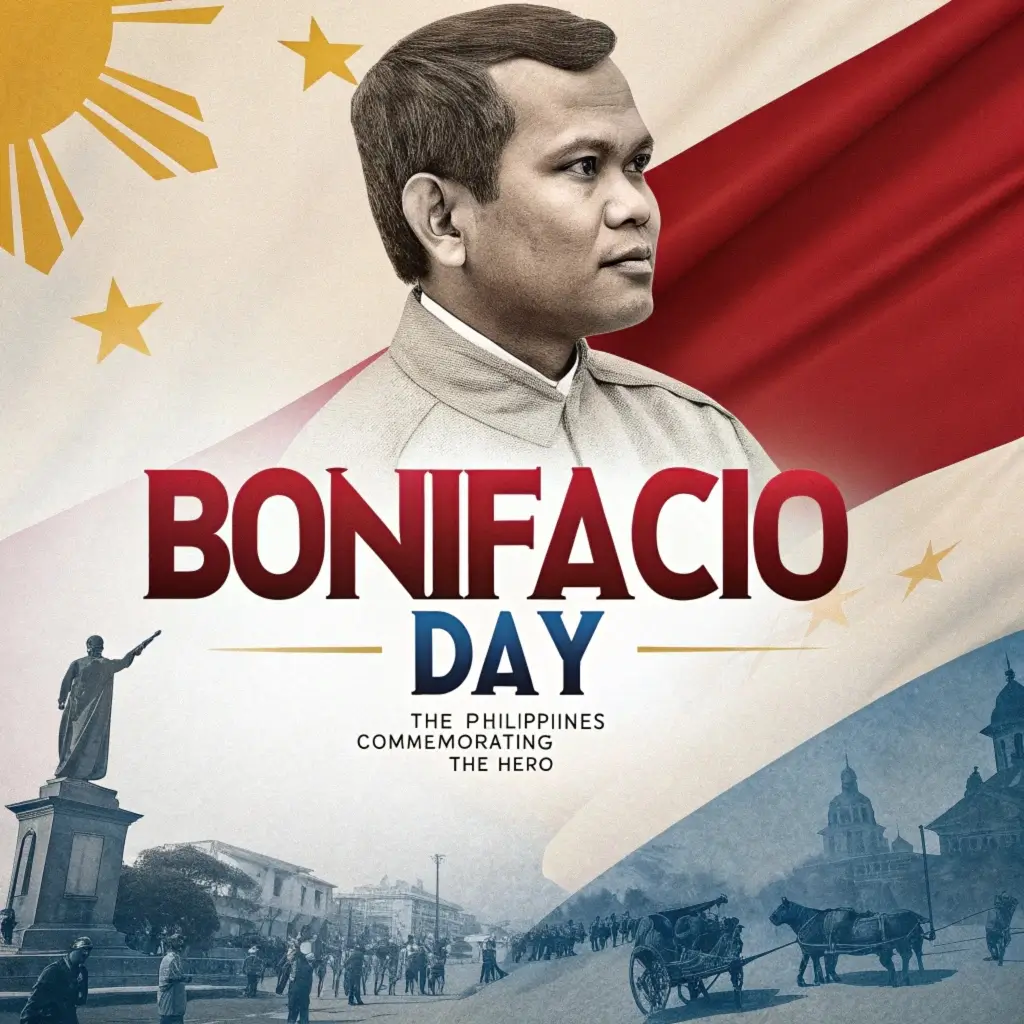
Andres Bonifacio was a key figure in the Philippine Revolution. He was born on November 30, 1863, in Tondo, Manila. Bonifacio wanted to free the Philippines from Spanish rule.
He started the Katipunan in 1892. This secret society aimed to gain full independence through armed struggle.
In August 1896, the revolution grew stronger. Bonifacio stood out for his dedication to freedom. The Katipunan grew to 100,000 members in Manila, showing broad support for his cause.
Despite facing setbacks, Bonifacio never gave up. His efforts sparked a strong desire for freedom among Filipinos. However, internal conflicts led to his execution on May 10, 1897.
His death did not stop the fight for freedom. Bonifacio’s legacy inspired many to continue the struggle. His dedication to Filipino nationalism remains a powerful symbol.
Key Events in the Revolution
The Philippine Revolution was a key moment in the fight for freedom from Spanish rule. It was marked by important events that showed the Filipino people’s determination. The Cry of Pugad Lawin was a key moment, symbolizing defiance and the start of the fight for freedom.
The Cry of Pugad Lawin
The Cry of Pugad Lawin happened on August 23, 1896. It marked the start of the revolution. Andres Bonifacio and the Katipunan tore their cedulas, showing they rejected Spanish rule.
This act inspired many Filipinos who felt oppressed. It sparked a rebellion across provinces, starting a minor revolution. This would grow into a bigger fight for independence.
Major Battles and Conflicts
Andres Bonifacio led many battles and conflicts during the revolution. One early battle was the Battle of San Juan del Monte. Despite early wins, Bonifacio faced big challenges in leading the military.
He had conflicts with Emilio Aguinaldo, causing divisions in the forces. These issues affected the Katipunan’s success and direction during a crucial time in Philippine history.
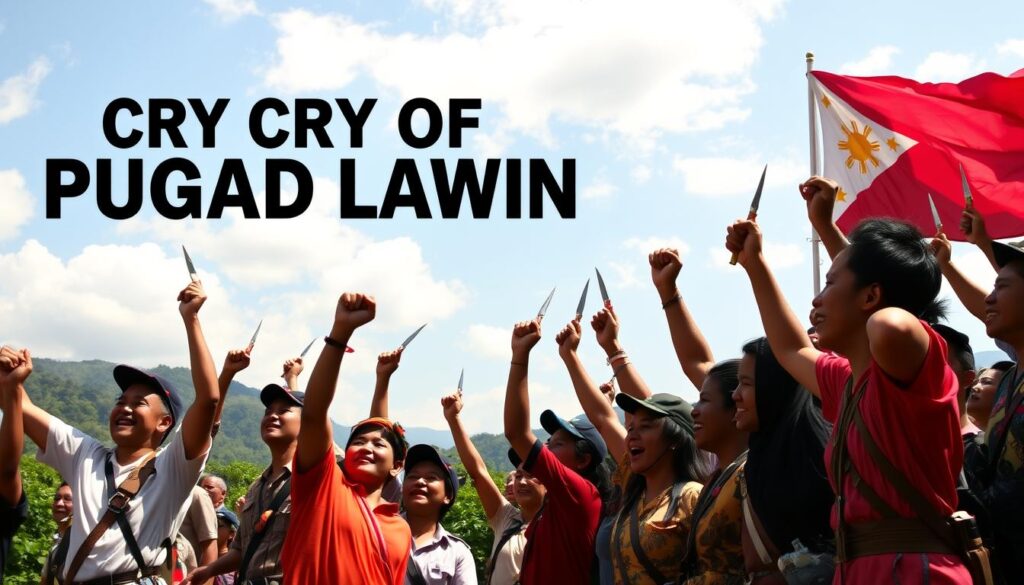
Leadership Struggles
The Philippine Revolution faced many leadership challenges. Andres Bonifacio and Emilio Aguinaldo had different views on how to fight for freedom. Their disagreements led to a big split in the movement.
Conflict with Emilio Aguinaldo
Bonifacio and Aguinaldo had different plans for the Philippines. Aguinaldo’s approach was seen as more acceptable by others. This made Bonifacio feel left out.
Bonifacio was a skilled leader who helped start the fight against Spain. But, he struggled to keep up with the changing politics.
Bonifacio’s Arrest and Trial
In 1897, Bonifacio was arrested and later tried for treason. Many thought this was a move by Aguinaldo’s supporters to get rid of him. Despite his lack of formal education, Bonifacio was known for his leadership skills.
His trial was seen as unfair. It showed how politics can affect justice. Bonifacio’s story teaches us about the value of education and dedication in leadership.
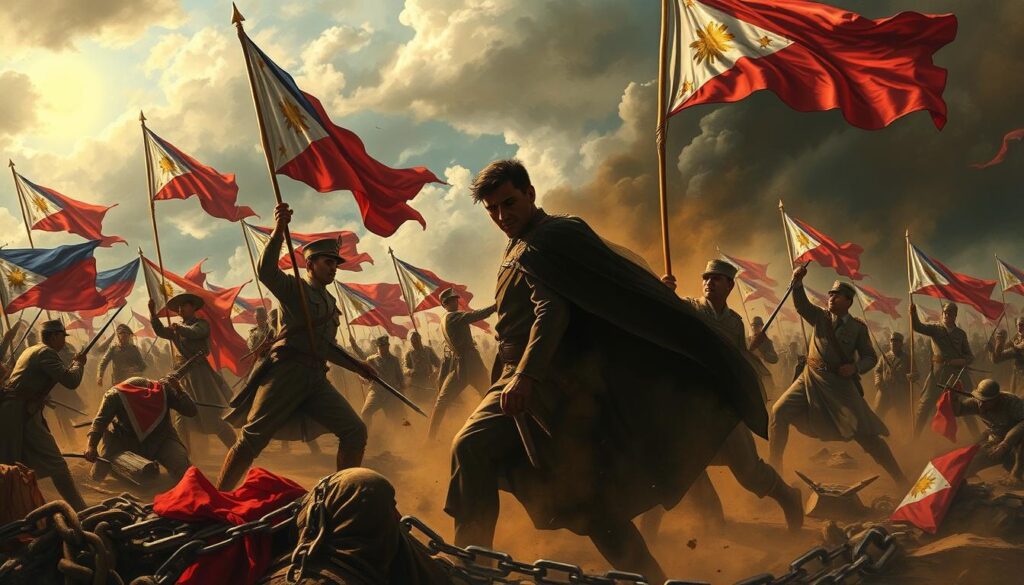
| Key Events | Details |
|---|---|
| Foundation of KKK | Established by Bonifacio in 1892, it became a foundation for revolutionary efforts in Luzon. |
| The Cry of Pugad Lawin | A significant uprising in 1896 that signified the start of the armed struggle against Spanish colonial rule. |
| Bonifacio’s Arrest | He was captured in 1897 after being ousted and accused of treason. |
| Treason Trial | Bonifacio’s trial reflected political rivalries and was seen as a significant injustice. |
The Execution of Andres Bonifacio
Andres Bonifacio’s execution on May 10, 1897, was a key moment in Philippine history. He was a leading figure in the fight for independence. His death made him a symbol of freedom, affecting the nation’s view of fighting against colonial rule.
Circumstances Surrounding His Death
Bonifacio was caught by Emilio Aguinaldo’s forces. This led to a trial that decided his fate. The Tejeros Convention in March 1897 had already caused tension, leading to a split in the movement.
After being captured in Maragondon’s mountains, Bonifacio was found guilty of treason. He was sentenced to death. On his execution day, he and his brothers faced a firing squad from the Magdalo faction.
Historical Reactions to His Execution
Reactions to Bonifacio’s execution were mixed but mostly outraged. Many saw him as a martyr, sparking deep feelings for freedom. His death made him a legendary figure in Philippine history.
Friends and admirers mourned his loss, seeing it as unjust. This solidified his status as a national hero. Over time, Bonifacio inspired many to fight for their rights.
Legacy of Andres Bonifacio
Andres Bonifacio’s legacy is key to Filipino history. He is a national hero, symbolizing the fight for freedom and independence. His life and contributions to the revolution inspire many, showing the value of selfless service to the nation.
Every year, his legacy is celebrated in many ways. This reinforces his importance in the hearts of Filipinos.
Bonifacio as a National Hero
Andres Bonifacio’s impact on Philippine history is vast. He is known as the “Father of the Philippine Revolution,” leading the fight against Spanish rule. Schools in the Philippines teach his story and efforts early on.
However, awareness of him grows as people get older. Views on Bonifacio Day vary, with some seeing it as just a holiday, not a tribute to his legacy.
Modern Commemorations and Recognition
Bonifacio’s contributions are remembered in modern times. His birthday, November 30th, is a national holiday. Schools, monuments, and community events help keep his significance alive today.
This recognition shows a collective respect for his struggle and ideals. It influences discussions on nationalism and identity in the Philippines.
Historical Significance in Philippine History
Andres Bonifacio is a key figure in Philippine history, marking a crucial moment in the fight for freedom. Born on November 30, 1863, in Tondo, Manila, his early life was shaped by hardship. He lost his parents young and had to work hard to survive.
Despite limited formal education, Bonifacio became self-educated. He read a lot about revolutionary ideas. This fueled his desire for change.
He joined the Katipunan, a secret society, on July 7, 1892. Bonifacio played a key role in its growth. He wanted to unite Filipinos against Spanish rule.
The Philippine Revolution, led by Bonifacio in 1896, was a turning point. It showed a deep desire for freedom across the islands. His leadership inspired many to keep fighting for freedom.
Tragically, Bonifacio was executed on May 10, 1897, by Emilio Aguinaldo. This showed the internal struggles of the revolution. Yet, his legacy lives on, symbolizing the ongoing quest for independence.
The Impact of Bonifacio’s Ideology
Andres Bonifacio’s ideas were key in shaping Filipino nationalism in the late 19th century. He believed in fighting for full freedom, not just small changes. This belief united many Filipinos under the Katipunan, which he helped start in 1892.
The Katipunan grew fast, showing a strong wish for freedom. Despite tough colonial rule, people wanted to be free.
Bonifacio pushed for action, not just words. The Katipunan’s Dekalogo, a ten-point guide, showed the group’s goals. It talked about duties to God, country, family, and community. This inspired many to join the Katipunan, creating a strong belief among Filipinos.
His work also inspired others after he was gone. His ideas helped future leaders fight for freedom. He made people see themselves as one, ready for self-governance.
Bonifacio worked with others like Emilio Jacinto, strengthening the Katipunan. Jacinto’s writings, like the Kartilya, added depth to Bonifacio’s ideas. Together, they encouraged good living and the fight for freedom.
In short, Bonifacio’s ideas changed the Philippines. His fight for freedom inspired many. His legacy continues to shape the nation’s quest for freedom and self-rule.
Comparisons with Other Nationalist Leaders
Andres Bonifacio is a key figure in Philippine nationalism. He stands out when compared to leaders like José Rizal and Emilio Aguinaldo. Their actions and ideas show the depth of the Philippine Revolution.
José Rizal wanted change through education and civic action. His writings encouraged Filipinos to seek reform peacefully. Bonifacio, however, believed in direct action against colonial rule. This shows their different visions for the Philippines.
Emilio Aguinaldo started as a fellow revolutionary with Bonifacio. But he later took a different path. Aguinaldo’s leadership combined Bonifacio’s passion with strategic thinking. This shows the complexity of nationalist leaders during the revolution.
The following table provides further insights into the fundamental distinctions among these influential nationalist figures:
| Leader | Born | Died | Approach | Key Activities |
|---|---|---|---|---|
| Andres Bonifacio | 1863 | 1897 | Revolutionary | Founded Katipunan, led armed resistance |
| José Rizal | 1861 | 1896 | Reformist | Wrote ‘Noli Me Tangere’ and ‘El Filibusterismo’ |
| Emilio Aguinaldo | 1869 | 1964 | Mixed approach | Led Philippine Revolution, first president of the republic |
Looking at Bonifacio and other leaders helps us understand the Philippine Revolution. It shows the different ways people fought for independence.
Bonifacio’s Contribution to Filipino Nationalism
Andres Bonifacio’s legacy is key in shaping Filipino nationalism. His work helped start the Philippine Revolution and united Filipinos in their quest for freedom. Today, his impact inspires many to fight for their rights and identity.
Influence on Future Generations
Bonifacio’s story shows the lasting effect of his vision. His call for unity against oppression still echoes today. Efforts to honor him alongside other heroes like Jose Rizal are ongoing in schools.
In our global world, national identity has grown more complex. Bonifacio’s leadership reminds us of the need to stand up for our beliefs and include everyone in our stories. This push for a more complete history of the Philippines is underway.
| Key Contributions | Impact on Future Leaders |
|---|---|
| Founded the Katipunan in 1892 | Inspired movements for freedom and equality |
| Promoted the ideals of unity | Encouraged collective action against oppression |
| Advocated for social justice | Influenced policies addressing inequality |
| Symbol of martyrdom | Serves as inspiration for future activists |
Conclusion
Andres Bonifacio’s legacy is key to the Philippine Revolution’s story. Born on November 30, 1863, in Manila, he fought for freedom and justice. His work in the Katipunan was crucial, especially after José Rizal’s arrest in 1892.
This sparked a desire for independence among Filipinos. His sacrifices helped shape the democracy we enjoy today. They also shaped the Filipino identity.
About 42% of Filipinos are under 18, showing the nation’s hope. The saying “Ang kabataan ang pag-asa ng bayan” highlights the youth’s role. It shows how important they are in the fight for freedom and identity.
Andres Bonifacio’s ideas still inspire today. They encourage future generations to talk about sovereignty and democracy. His contributions to history continue to motivate many.
The 1986 EDSA People Power Revolution was a big event. Millions came together to stand up for their rights. Bonifacio’s life and the Philippine Revolution’s growth show the spirit of revolution in Filipino society.
His legacy reminds us that the fight for freedom is ongoing. It’s not just history but a living dream for many seeking a better future.



